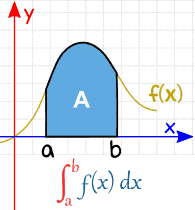Let f be a real valued continuous function on [0, 1] and
\(f(x) = x + \int_{0}^{1} (x - t) f(t) \,dt\)
Then, which of the following points (x, y) lies on the curve y = f(x)?
Let f be a real valued continuous function on [0, 1] and
\(f(x) = x + \int_{0}^{1} (x - t) f(t) \,dt\)
Then, which of the following points (x, y) lies on the curve y = f(x)?
- (2, 4)
- (1, 2)
- (4, 17)
- (6, 8)
The Correct Option is D
Solution and Explanation
The correct answer is (D) : (6,8)
\(f(x) = x \int_{0}^{1} (x - t) f(t) \,dt\)
\(f(x) = x + x\int_{0}^{1} f(t) \,dt - \int_{0}^{1} t \cdot f(t) \,dt\)
\(f(x) = x \left(1 + \int_{0}^{1} f(t) \,dt \right) - \int_{0}^{1} t \cdot f(t) \,dt\)
Let
\(1 + \int_{0}^{1} f(t) \,dt = a \quad \text{and} \quad \int_{0}^{1} t \cdot f(t) \,dt = 1\)
f(x) = ax-b
Now,
\(a = 1 + \int_{0}^{1} (at - b) \,dt = 1 + \frac{a}{2} - b \implies \frac{a}{2} + b = 1\)
\(b = \int_{0}^{1} t(at - b) \,dt = \frac{a}{3} - \frac{b}{2} \implies \frac{3b}{2} = \frac{a}{3} \implies b = \frac{2a}{9}\)
\(\frac{a}{2} + \frac{2a}{9} = 1\)
\(⇒ a = \frac{18}{13}\) \(b = \frac{4}{13}\)
\(ƒ(x) = \frac{18x-4}{13}\)
(6,8) lies on f(x)
Top Questions on Definite Integral
- Evaluate the definite integral: \( \int_{-2}^{2} |x^2 - x - 2| \, dx \)
- MHT CET - 2025
- Mathematics
- Definite Integral
The value \( 9 \int_{0}^{9} \left\lfloor \frac{10x}{x+1} \right\rfloor \, dx \), where \( \left\lfloor t \right\rfloor \) denotes the greatest integer less than or equal to \( t \), is ________.
- JEE Main - 2024
- Mathematics
- Definite Integral
- The value of \(\lim_{{n \to \infty}} \sum_{{k=1}}^{n} \frac{n^3}{{(n^2 + k^2)(n^2 + 3k^2)}}\) is
- JEE Main - 2024
- Mathematics
- Definite Integral
If the value of the integral
\[ \int_{-\frac{\pi}{2}}^{\frac{\pi}{2}} \left( \frac{x^2 \cos x}{1 + \pi^x} + \frac{1 + \sin^2 x}{1 + e^{\sin^x 2023}} \right) dx = \frac{\pi}{4} (\pi + a) - 2, \]
then the value of \(a\) is:
- JEE Main - 2024
- Mathematics
- Definite Integral
- For \( x \in \left( -\frac{\pi}{2}, \frac{\pi}{2} \right) \), if\[y(x) = \int \frac{\csc x + \sin x}{\csc x \sec x + \tan x \sin^2 x} \, dx\]and\[\lim_{x \to -\frac{\pi}{2}} y(x) = 0\]then \( y\left(\frac{\pi}{4}\right) \) is equal to
- JEE Main - 2024
- Mathematics
- Definite Integral
Questions Asked in JEE Main exam
Let one focus of the hyperbola \( H : \dfrac{x^2}{a^2} - \dfrac{y^2}{b^2} = 1 \) be at \( (\sqrt{10}, 0) \) and the corresponding directrix be \( x = \dfrac{9}{\sqrt{10}} \). If \( e \) and \( l \) respectively are the eccentricity and the length of the latus rectum of \( H \), then \( 9 \left(e^2 + l \right) \) is equal to:
- JEE Main - 2025
- Conic sections
- Let \( \alpha_1 \) and \( \beta_1 \) be the distinct roots of \( 2x^2 + (\cos\theta)x - 1 = 0, \ \theta \in (0, 2\pi) \). If \( m \) and \( M \) are the minimum and the maximum values of \( \alpha_1 + \beta_1 \), then \( 16(M + m) \) equals:
- JEE Main - 2025
- Maxima and Minima
- Let the line \( x + y = 1 \) meet the circle \( x^2 + y^2 = 4 \) at the points A and B. If the line perpendicular to AB and passing through the midpoint of the chord AB intersects the circle at C and D, then the area of the quadrilateral ABCD is equal to:
- JEE Main - 2025
- Coordinate Geometry
- The number of different 5 digit numbers greater than 50000 that can be formed using the digits 0, 1, 2, 3, 4, 5, 6, 7, such that the sum of their first and last digits should not be more than 8, is:
- JEE Main - 2025
- permutations and combinations
- Two identical symmetric double convex lenses of focal length \( f \) are cut into two equal parts \( L_1, L_2 \) by the AB plane and \( L_3, L_4 \) by the XY plane as shown in the figure respectively. The ratio of focal lengths of lenses \( L_1 \) and \( L_3 \) is:

Concepts Used:
Definite Integral
Definite integral is an operation on functions which approximates the sum of the values (of the function) weighted by the length (or measure) of the intervals for which the function takes that value.
Definite integrals - Important Formulae Handbook
A real valued function being evaluated (integrated) over the closed interval [a, b] is written as :
\(\int_{a}^{b}f(x)dx\)
Definite integrals have a lot of applications. Its main application is that it is used to find out the area under the curve of a function, as shown below:
